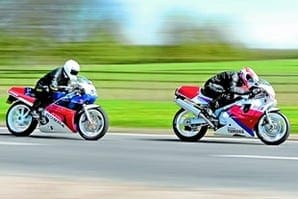
There’s a bloke in the office downstairs from CMM who’s just got permission from his wife to use some of their savings to buy three classic motorcycles. A Ducati 888, a 996SPS and an MV F4. Now this bloke is no mug. He’s got three beautiful machines for the right price and in 10 years time he’ll have doubled his money. That same dosh left in the bank right now would be making half a per cent of sweet sod-all.
But he should have bought an RC30 because, make no mistake, they are the next Vincent, the next Brough Superior, the next Gold Star and even at an eye-watering £11,000, a decent RC30 is still a bargain. And believe me, prices are set to go exponential for a good one.
Enjoy more Classic Motorcycle Mechanics reading in the monthly magazine.
Click here to subscribe & save.
B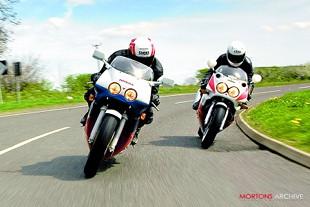 ecause, apart from anything else, a decent RC30 is still a great bike to ride. Truth be told I don’t like the idea of buying as an investment, but as a former RC owner (and the one who sold his just as they were about to double in value) I’d happily do it again. Because even now, 23 years after we first set eyes on it, Honda’s race bike for the road is still capable of holding its own on a bumpy British B-road, still capable of making you feel like Yer Maun and, in the hands of some French nutters last year, still capable of finishing 25th in the Le Mans 24 hour race against a field of 1000cc super bikes making 50 percent more horsepower. They really are that good.
ecause, apart from anything else, a decent RC30 is still a great bike to ride. Truth be told I don’t like the idea of buying as an investment, but as a former RC owner (and the one who sold his just as they were about to double in value) I’d happily do it again. Because even now, 23 years after we first set eyes on it, Honda’s race bike for the road is still capable of holding its own on a bumpy British B-road, still capable of making you feel like Yer Maun and, in the hands of some French nutters last year, still capable of finishing 25th in the Le Mans 24 hour race against a field of 1000cc super bikes making 50 percent more horsepower. They really are that good.
But there are some people who don’t get it. Ben, the editor, understands the fascination, and appreciates the Honda’s qualities, but he never wanted one. He wants a Yamaha OW01. And the more people I talk to the more it seems that there is a chasm between them. One side or the other, Yamaha or Honda, Hizzy or Foggy – there’s a clear divide.
And then we got talking. When was the last time we saw the two bikes tested back to back? No, us neither. Time to make a few calls.
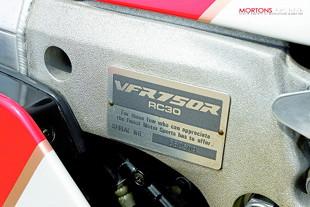 Honda VFR750R RC30
Honda VFR750R RC30
Head down, tucked in as much as I can get my six-foot, 13-stone Anglo Saxon frame crammed into this tiny motorcycle, accelerating hard through third, fourth and fifth gears. Flick left, apex, think and it comes upright as if guided by the hand of Joey. Hard right. Sweat dribbling down my neck. Eyes on stalks, ears in heaven. That noise, that drone – the small bore standard RC pipe is working hard. Revs are high – more than I’d like on a borrowed bike, but the big bang firing order is deceptive. It grips like we’re just mucking about, sounds like midrange, goes like a rocket. Unless you look down you’d never realise.
I know this road – it’s my personal TT; twisty as a dancing snake and we’re doing well. Very well. Seven miles later the unofficial clock stops. How fast? I’m not telling but it’s faster than I did it last summer on an 09 YZF-R1 – let’s just say I may have been guilty of doing 22mpg in a 40mpg limit if you get my drift.
Now it’s coming back to me. The thing that makes these bikes so good is that usability. They don’t feel fast, but they are. They don’t feel scary, but replay the run and they are. If ever any meddling Eurocrat needed a case to convince me that a 100bhp limit is a good thing, give me an RC30 and tell me to go and play.
'And if you’re paying as much as a brand new FireBlade for a 13-year-old Honda 750, then you’ve got every right to expect perfection.'
OK, I’m biased. Been there, done that, bought the bike and loved it. But I sold it too so that’s gotta make my opinion worth hearing. I spent 10 years telling anyone who’d listen that I was going to buy an RC30 one day. And then someone called my bluff. ‘What’s stopping you?’ Good point. So I bit the bullet, got a loan and bought one. Which sounds simple but it took more than six months to find the right bike. Because back then, in late 2000/01 there were still a lot of lashed-up ex-race bikes out there masquerading as the real deal. And if you’re paying as much as a brand new FireBlade for a 13-year-old Honda 750, then you’ve got every right to expect perfection. Anyhow, to cut a long story short, I got a beauty; a low miles de-restricted Japanese-spec bike and then spent the next three summers commuting, thrashing and gliding around Cadwell Park. It was good on the track, but so much better on the road.
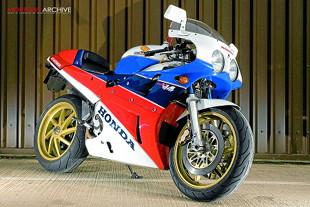 Honda did something special with the RC30. They took their all-conquering RVF endurance racer and built a ready-made competition bike that was equally as good at winning WSB as it was the TT. It beat hand-built specialist F1 machines straight from the crate and made a pretty good street bike too.
Honda did something special with the RC30. They took their all-conquering RVF endurance racer and built a ready-made competition bike that was equally as good at winning WSB as it was the TT. It beat hand-built specialist F1 machines straight from the crate and made a pretty good street bike too.
Easy to ride, the most precise carburation of any machine ever, suspension that looked like the rest but somehow gave sublime ride quality and control in any kind or corner too and brakes that still feel OK 23 years later. And then there was that engine. Stuffed full of HRC thinking, and, if the rumours (and the promotional video – search YouTube for RC30 assembly) were to be believed, hand built by artists in white gloves. Good enough to win any 24 hour race, reliable enough to do crazy mileages and way, way faster than the power figures suggested because the RC’s other secret – and the reason it cost so much money – was weight. Making it 20kg lighter than a Suzuki GSX-R, ZXR or FZ750 involved substantial use of aluminium everywhere. That lack of mass let the Honda accelerate harder on less power and steer faster too. The tiny wheelbase with all that power and a tendency to sit low at the back should have been a recipe for tankslappers, but RCs are generally stable machines in road trim at least.
And accurate. Boy, do they steer. Pick a point, shift a cheek off the seat and just nail it. Every time. Yes, that good, that special. So how come I sold it?
Because there’s a price to pay for owning an HRC-developed racer as your only bike. For having that enormous loan hanging over your head. Every time you ride it, you’re watching the temperature gauge. Keep moving and it’s fine. Get stuck in summer traffic and you risk those tiny, ‘built-to-lap-the-TT-not-sit-in-traffic’ radiators giving up the fight against the even tinier cooling fan. And because you can’t (or couldn’t back then) get back tyres for the standard rear wheel and so every possible mile has to be nursed out of the 10-year-old sports touring rubber you have fitted. And because, like most of us, I got itchy feet. I just fancied something else and the RC had to go to pay for it.
Ten years on and prices have doubled but after riding this one yesterday I’m seriously considering another.
 Yamaha OW01
Yamaha OW01
Chalk and cheese. Where the Honda flatters and makes going very fast so very easy, the Yamaha makes you work for every mph. Perched high on top of what feels like a well put together Harris or Spondon special I’ve got the twistgrip wound almost fully round and there’s still more to come. Plenty of revs but we’re still to find the real power. And then it comes in with a bang, just as the tacho chimes 12, already into the red. Jeez this is hard work.
How you can make a 110bhp 750 engine feel like the world’s angriest FZR400 I will never know. But strangely, I’m getting to like it – if you’re going to build a race bike for the road, then I suppose it should feel and sound like a race bike. This one is owned by a racer and judging by the state of the tyres, it’s had some fairly recent and committed track use. The set-up is personal I suppose. You sit tall and the footpegs are high and set a long way back forcing you to almost lie prone on the tank reaching for the bars set an inch below the top yoke.
The OW takes a sharp nudge to make it turn but once over is as stable and solid as a rock, holding a line through bumpy corners, ready to fire out the other side. Fine in theory, but I’m struggling with the revs again. You have to go into a turn with the tacho banging on the redline because once settled and the revs drop a couple of thou’ you need to be close enough to the limit to take the engine into the red as quickly as possible to get the drive. Hard work? I should say so. But like I said, it’s growing on me.
And parked up for a break, I just want one, pure and simple. That brutal design, those simple, but stunning colours, the stripped-down aggressive styling. Move over Ducati, I think this might be the best looking bike ever.
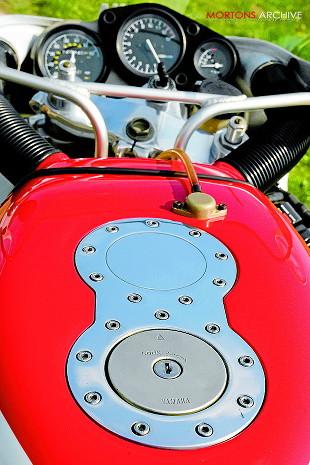 Time has been kind to the OW01. The benefit of arriving a year or so later than the RC30 meant the Japanese had finally worked out the blueprint for hardcore sports bikes, including, crucially, a 17-inch rear wheel. Honda made a big thing of the link between the RVF racer and RC30, Yamaha had the YZF750 Genesis – an exotic Suzuka race bike, occasionally glimpsed in this country in the centrespread of a magazine in those gorgeous Tech 21 colours with Lawson, Rainey or even on one occasion, King Kenny at the controls.
Time has been kind to the OW01. The benefit of arriving a year or so later than the RC30 meant the Japanese had finally worked out the blueprint for hardcore sports bikes, including, crucially, a 17-inch rear wheel. Honda made a big thing of the link between the RVF racer and RC30, Yamaha had the YZF750 Genesis – an exotic Suzuka race bike, occasionally glimpsed in this country in the centrespread of a magazine in those gorgeous Tech 21 colours with Lawson, Rainey or even on one occasion, King Kenny at the controls.
They never quite convinced us that the OW01 was the YZF street bike, but in truth, Yamaha didn’t care about selling OWs for the road. There was no promotional video with plinky-plonk classical piano or white gloves and slo-mo. If Yamaha had made a video for this bike it most probably would have involved chainsaws, explosions and thrash metal. They never had a press bike and didn’t encourage road tests. Few were sold at the time and so the OW’s cult following took time to build.
Ten years ago a decent OW01 cost half the price of an RC30; these days things are much closer. In many ways the Yamaha is the more exotic bike. In standard trim it makes 20bhp more than the Honda and weighs a couple of kilos less. Back in 1989, the Honda’s race kit involved replacing most of the engine and suspension. The kit for the OW01 was essentially a noisy end can and carb kit.
Like the Honda, the Yamaha’s engine bore little resemblance to the road going FZ750. A bigger bore and shorter stroke gave more valve area and a higher rev ceiling. 38mm slingshot-type half-slide, half CV carbs and an EXUP valve helped make it rideable, but ultimately cost it race success because WSB rules stated that the bikes must race with the same type of carbs as the road versions and the FZR’s didn’t work well with race tuned engines.
Most were raced and many ended up fitted with FZR1000 engines on the Irish road circuits. Which makes buying a good one even harder than ever. It took a few years for the specialist networks to build and a guru to emerge. That bloke is Peter Day – a man who knows more about OW01s than most and has a stock of spares that’ll keep most bikes going for a while yet.
From what I can gather they tend to get ridden. Hard. There’s no devoted owners' club yet – just a band of isolated enthusiasts, who know why they want one and don’t feel the need to wrap their bikes in cotton wool.
But as me and the FZR head back to the office, there’s a bond forming. It's a challenging machine that doesn‘t suffer foolish riding. And I like that. But I’m a road rider and this is a track bike. Ben is a former racer, so it fits him better.
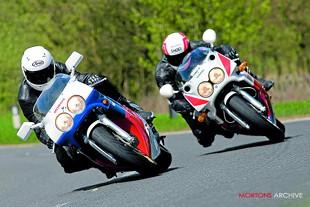 Buying an RC30 or OW01
Buying an RC30 or OW01
The bikes might be getting older (and pricier) but in many ways there’s never been a better time to buy. Doting owners have spent years putting the little things right and even the old ex-race bikes are now mostly back to original and immaculate.
Don’t get giddy. Just because the current owner says it was never raced, doesn’t mean that the owner before him or the one before that didn’t know different. Most RC30s and OW01s were finished in racing by the mid-1990s and will have been back on the road in some form or another for 15 years or more.
The best advice for both bikes is take your time. Let the seller know that you expect to inspect the bike thoroughly. Even better, join the RC owners' club and ask their advice or talk to Peter Da for the OW01. Most of the bikes in the UK are known to them and they’ll be more than happy to help you out.
Some of the grey importers are still bringing in bikes from Japan. Be excited, but realistic too. The important thing is that everything is there. Faults can be fixed, but irreplaceable parts are harder to sort out.
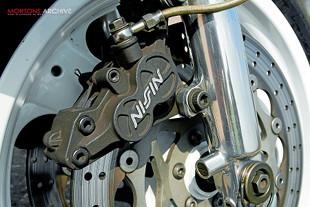 The Japanese-spec RC30s (small headlights, black mirrors) should be the most collectable because they were the first 1000 off the production line and came with a plaque on the frame and a special key with a carbon-fibre inlay. They were restricted to 77bhp. Many were derestricted (if you were a Japanese owner who’d had to be entered into a draw for the right to buy one and then paid a fortune for your bike wouldn’t the first thing you did to your bike be to derestrict it too?). The differences are CDI unit, carb settings, silencer and airbox. A healthy full power bike makes 95bhp and revs hard to the redline, a restricted machine makes 77bhp and goes flat after 9000rpm.
The Japanese-spec RC30s (small headlights, black mirrors) should be the most collectable because they were the first 1000 off the production line and came with a plaque on the frame and a special key with a carbon-fibre inlay. They were restricted to 77bhp. Many were derestricted (if you were a Japanese owner who’d had to be entered into a draw for the right to buy one and then paid a fortune for your bike wouldn’t the first thing you did to your bike be to derestrict it too?). The differences are CDI unit, carb settings, silencer and airbox. A healthy full power bike makes 95bhp and revs hard to the redline, a restricted machine makes 77bhp and goes flat after 9000rpm.
Buying a OW01 is probably more tricky than buying an RC30, if only for the fact that almost all OWs were raced. Genuine road only bikes are few and far between but they are out there. An ex-race bike can make a good buy too, especially if you intend to ride it rather than keep it as a museum or show machine. Just get somebody who knows what they’re looking at to give it the once over. Peter Day can source machines for you.
Don’t forget that these are old bikes, many of which have been sat doing nothing for years and so you can expect that almost anything might need replacing. The best buys if you want to ride them are those bikes that are used and serviced regularly. And you will want to ride them, believe me. ![]()
Advert
 Enjoy more Classic Motorcycle Mechanics reading in the monthly magazine. Click here to subscribe.
Enjoy more Classic Motorcycle Mechanics reading in the monthly magazine. Click here to subscribe.










